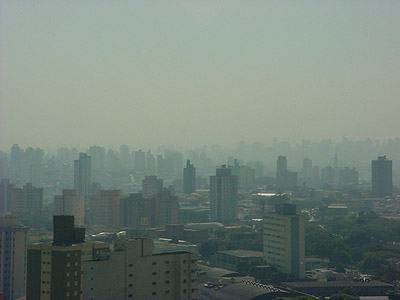Pesquisa conclui que exposição à poluição durante a gravidez aumenta o risco de asma no bebê

Risco de a criança contrair a doença respiratória é aumentado por mudanças genéticas ocorridas no útero
A exposição de uma mulher grávida a um ambiente com muita poluição aumenta o risco de a criança contrair asma devido a mudanças genéticas ocorridas dentro do útero. A descoberta, feita por pesquisadores da Universidade de Cincinnati e da Escola de Saúde Pública Mailman da Universidade Columbia, nos Estados Unidos, foi publicada na revista científica Public Library of Science (PLoS). Matéria da Agência EFE, com informações adicionais do EcoDebate
Depois de estudar o sangue do cordão umbilical de bebês nascidos em Nova York, os pesquisadores descobriram uma relação entre exposição da mãe ao ar contaminado por fuligem de veículos, alterações epigenéticas e o surgimento da asma na criança antes dos 5 anos de idade.
A exposição a hidrocarbonetos aromáticos policíclicos (PAH, na sigla em inglês) – compostos produzidos durante a queima incompleta de combustíveis com carbono – já foi associada ao desenvolvimento de uma série de doenças, entre elas o câncer e a asma infantil.
Comprovou-se agora que até mesmo o feto sofre os efeitos da poluição enquanto está no útero materno. Os PAH desencadeiam uma alteração epigenética no gene ACSL3, relacionado ao metabolismo no pulmão. As mudanças epigenéticas perturbam o desenvolvimento dos genes e, desta forma, influenciam a sua atividade, mas sem gerar mudanças estruturais ou mutações no material genético.
Os cientistas consideram que a exposição aos PAH por meio da placenta pode reprogramar genes do feto relacionados à inflamação das vias respiratórias e à asma na infância. A equipe analisou glóbulos brancos do sangue de cordão umbilical de 56 bebês, em busca de quaisquer alterações epigenéticas relacionadas à exposição pré-natal à substância tóxica. Antes, os especialistas confirmaram a exposição das mães a um ambiente de alta poluição durante a gravidez.
Descobriram, assim, uma clara relação entre mudanças no gene ACSL3, exposição materna aos PAH e a aparição de sintomas de asma antes dos 5 anos. Segundo os pesquisadores, transformações epigenéticas no ACSL3 poderiam servir como indicadores do risco de uma criança contrair asma.
“Nossa pesquisa apoia a ideia de que os poluentes podem interagir com os genes durante períodos chave do desenvolvimento e, assim, desencadear o aparecimento de doenças anos mais tarde”, explica o responsável pela pesquisa, Shuk-mei Ho.
* Matéria da Agência EFE, no O Estado de S.Paulo, 15/02/2009.
Nota do EcoDebate: o artigo “Relation of DNA Methylation of 5?-CpG Island of ACSL3 to Transplacental Exposure to Airborne Polycyclic Aromatic Hydrocarbons and Childhood Asthma“, publicado pela Plos ONE, está disponível para acesso integral no formato HTML. Para acessar o artigo clique aqui.
Para maiores informações publicamos, abaixo, o abstract:
Abstract
In a longitudinal cohort of ~700 children in New York City, the prevalence of asthma (>25%) is among the highest in the US. This high risk may in part be caused by transplacental exposure to traffic-related polycyclic aromatic hydrocarbons (PAHs) but biomarkers informative of PAH-asthma relationships is lacking. We here hypothesized that epigenetic marks associated with transplacental PAH exposure and/or childhood asthma risk could be identified in fetal tissues. Mothers completed personal prenatal air monitoring for PAH exposure determination. Methylation sensitive restriction fingerprinting was used to analyze umbilical cord white blood cell (UCWBC) DNA of 20 cohort children. Over 30 DNA sequences were identified whose methylation status was dependent on the level of maternal PAH exposure. Six sequences were found to be homologous to known genes having one or more 5?-CpG island(s) (5?-CGI). Of these, acyl-CoA synthetase long-chain family member 3 (ACSL3) exhibited the highest concordance between the extent of methylation of its 5?-CGI in UCWBCs and the level of gene expression in matched fetal placental tissues in the initial 20 cohort children. ACSL3 was therefore chosen for further investigation in a larger sample of 56 cohort children. Methylation of the ACSL3 5?-CGI was found to be significantly associated with maternal airborne PAH exposure exceeding 2.41 ng/m3 (OR = 13.8; p<0.001; sensitivity = 75%; specificity = 82%) and with a parental report of asthma symptoms in children prior to age 5 (OR = 3.9; p<0.05). Thus, if validated, methylated ACSL3 5?CGI in UCWBC DNA may be a surrogate endpoint for transplacental PAH exposure and/or a potential biomarker for environmentally-related asthma. This exploratory report provides a new blueprint for the discovery of epigenetic biomarkers relevant to other exposure assessments and/or investigations of exposure-disease relationships in birth cohorts. The results support the emerging theory of early origins of later life disease development.
Citation: Perera F, Tang W-y, Herbstman J, Tang D, Levin L, et al. (2009) Relation of DNA Methylation of 5?-CpG Island of ACSL3 to Transplacental Exposure to Airborne Polycyclic Aromatic Hydrocarbons and Childhood Asthma. PLoS ONE 4(2): e4488. doi:10.1371/journal.pone.0004488
Editor: Catherine M. Suter, Victor Chang Cardiac Research Institute, Australia
Received: September 8, 2008; Accepted: December 19, 2008; Published: February 16, 2009
Copyright: © 2009 Perera et al. This is an open-access article distributed under the terms of the Creative Commons Attribution License, which permits unrestricted use, distribution, and reproduction in any medium, provided the original author and source are credited.
Funding: This work is in part supported by National Institutes of Health grants: ES009600 (FP), ES008977 (FP), ES015905 (FP, SMH, RM, DT), ES013071 (SMH), ES015584 (SMH), and ES006096 (SMH), ES016817 (WYT), the Department of Defense award DAMD W81XWH-06-1-0373 (WYT), the U.S. Environmental Protection Agency award RD-832141(FP), and the New York Community Trust (FP,RM, DT, JH). The funders had no role in study design, data collection and analysis, decision to publish, or preparation of the manuscript.
Competing interests: The authors have declared that no competing interests exist.
* E-mail: shuk-mei.ho{at}uc.edu
# These authors contributed equally to this work.
[EcoDebate, 17/02/2009]
Inclusão na lista de distribuição do Boletim Diário do Portal EcoDebate
Caso queira ser incluído(a) na lista de distribuição de nosso boletim diário, basta que envie um e-mail para newsletter_ecodebate-subscribe@googlegroups.com . O seu e-mail será incluído e você receberá uma mensagem solicitando que confirme a inscrição.